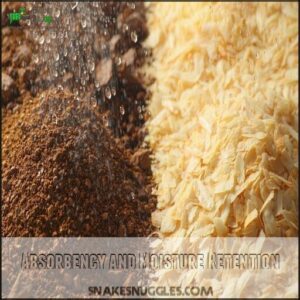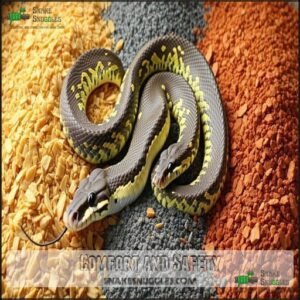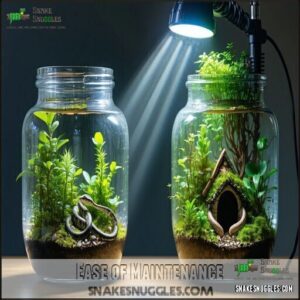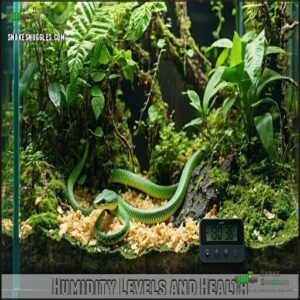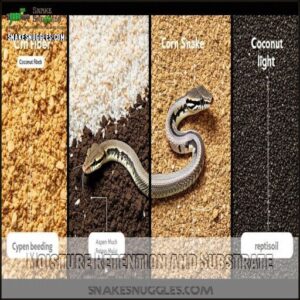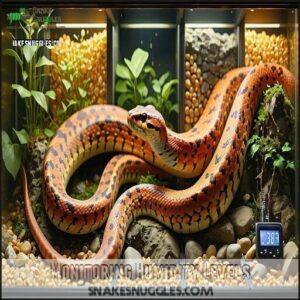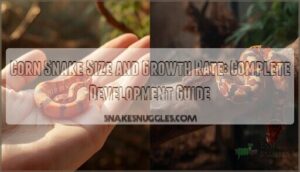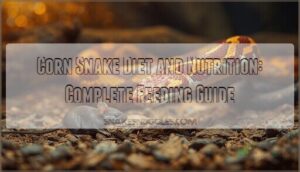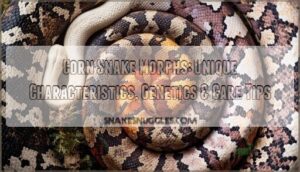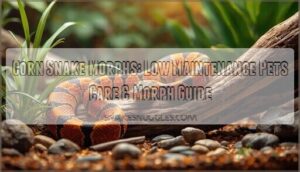This site is supported by our readers. We may earn a commission, at no cost to you, if you purchase through links.
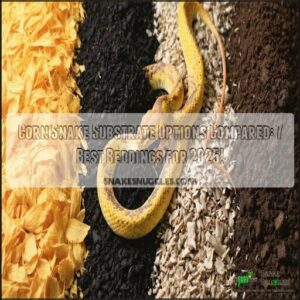 Choosing the right bedding is key to keeping your corn snake happy and healthy.
Choosing the right bedding is key to keeping your corn snake happy and healthy.
Popular options include aspen shavings, known for their absorbency and burrow-friendly texture, and cypress mulch, which helps maintain humidity.
Coconut fiber works well for tropical environments, while a DIY mix of organic soil, ReptiSoil, and sand creates a naturalistic setup.
Avoid dusty or sharp materials that could irritate your snake’s skin or respiratory system, and aim for substrates that are easy to clean, retain moisture, and promote natural behaviors like burrowing.
Ready to explore the pros and cons of top choices? Let’s uncover what works best for your snake!
Table Of Contents
Key Takeaways
- Choose a substrate that balances moisture control, burrowing capability, and safety for your corn snake.
- Avoid toxic or dusty materials like cedar or pine to prevent respiratory problems and impaction risks.
- Spot clean daily and replace the substrate every 3-4 weeks to maintain a clean environment.
- Use substrates like coconut fiber or cypress mulch to help regulate humidity and ensure smooth shedding.
Choosing Safe Substrate
You’ll need to select non-toxic materials like aspen or coconut fiber that prevent health risks such as impaction and respiratory issues.
Select safe substrates like aspen or coconut fiber to ensure your corn snake stays healthy, avoiding impaction and respiratory issues.
The right substrate allows your corn snake to burrow naturally while being easy to clean and maintain proper humidity levels.
Absorbency and Moisture Retention
A successful corn snake habitat depends largely on proper waste wicking and moisture control.
The ideal substrate absorbs waste efficiently while maintaining appropriate humidity levels.
For best bacterial prevention, choose substrates with high density that can retain moisture without becoming soggy.
Materials like coconut fiber and aspen offer excellent absorbent properties for your reptile’s enclosure.
Many owners prioritize bedding with high absorbency options for their reptile habitats.
Remember, moisture-retentive bedding helps regulate humidity control without creating unhealthy wet conditions, which is crucial for a healthy reptile habitat.
Comfort and Safety
Your snake’s comfort and safety should be your top priority when selecting corn snake substrate. Proper bedding prevents health issues while supporting natural burrowing behavior.
Four key safety considerations for snake bedding:
- Choose non-abrasive substrates to prevent scale damage
- Avoid toxic materials like cedar or pine that release harmful oils
- Select appropriate particle sizes to minimize impaction risks
- Verify substrates won’t cause injury when your snake burrows, ensuring the snake’s comfort and safety are maintained.
Ease of Maintenance
Time spent on substrate maintenance can make or break your corn snake keeping experience.
You’ll want bedding that simplifies your cleaning routine without sacrificing your pet’s health.
| Aspect | Low Maintenance | High Maintenance |
|---|---|---|
| Spot Cleaning | Easy waste visibility | Waste hides in substrate |
| Replacement Frequency | Every 2-3 months | Monthly or more |
| Cleaning Products | Water-safe disinfectants | Special cleaners required |
| Long-Term Cost | Lower replacement needs | Frequent complete changes |
The key factors to consider are Low Maintenance and High Maintenance options, which affect Spot Cleaning and Replacement Frequency, ultimately influencing the Long-Term Cost of keeping your pet.
Humidity Control Considerations
You’ll need to maintain 40-50% humidity for corn snakes while preventing excess moisture that causes mold or respiratory issues.
Your substrate choice directly affects this balance, with options like coconut fiber and cypress mulch offering better moisture retention than aspen bedding, which is crucial for preventing respiratory issues.
Humidity Levels and Health
Proper humidity levels directly impact your corn snake’s overall health.
Maintaining optimal humidity ensures your corn snake stays healthy, sheds properly, and thrives in a comfortable, natural-like environment.
Maintaining 40-50% humidity prevents respiratory health issues and guarantees smooth shedding.
Too dry, and your snake may develop stuck shed and dehydration.
Too humid, and they risk scale rot and respiratory infections.
The right corn snake substrate helps regulate these humidity levels naturally, and regular monitoring with a hygrometer is key for preventing health complications related to improper hydration levels.
Moisture Retention and Substrate
Different substrates retain moisture at varying rates, directly impacting your corn snake’s humidity levels.
Coconut fiber substrate holds water exceptionally well, while aspen snake bedding dries quickly.
For ideal humidity control, maintain substrate depth of 2-3 inches.
Cypress mulch offers balanced moisture retention without promoting mold growth.
Water absorption capacity matters—materials like ReptiSoil provide good burrowing benefits while regulating enclosure moisture.
Proper substrate moisture control is essential for reptile health.
Remember, the right substrate prevents health issues from excessive dampness or dryness.
Monitoring Humidity Levels
While maintaining proper humidity is vital for your corn snake’s health, regular monitoring guarantees ideal conditions.
Place a digital hygrometer in different areas of the enclosure to check for consistency. Respiratory infections can be avoided with proper humidity.
- Position hygrometers at both warm and cool ends to detect humidity fluctuations
- Monitor levels twice daily, especially after misting or substrate changes
- Watch for shedding issues as indicators of inadequate humidity
- Check for substrate drying during seasonal changes or when using heating elements
7 Best Substrate Options
You’ll find the perfect bedding for your corn snake among these seven top substrate options that balance moisture control, burrowing capability, and safety.
Each substrate has been tested extensively for effectiveness in maintaining proper humidity levels while providing a comfortable environment for your scaly friend, which is crucial for moisture control.
1. Zoo Med Reptisoil Reptile Substrate
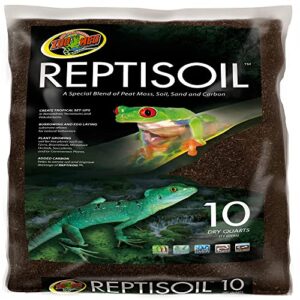
Zoo Med Reptisoil offers a special blend of peat moss, soil, sand, and carbon that’s perfect for corn snakes who enjoy burrowing.
The added carbon improves aeration and moisture retention without causing mold issues.
It’s safe for all life stages and supports natural behaviors like burrowing and egg-laying.
You’ll find it works well when mixed with coconut fiber or sphagnum moss for increased humidity control.
Many owners report success using it in bioactive setups with live plants.
For tanks larger than 30 gallons, you may need multiple 10-quart bags to achieve the recommended 3-inch depth.
Best For: Corn snake owners and reptile enthusiasts who want a natural, safe, and burrowing-friendly substrate for their snake’s enclosure.
- Enhances natural behaviors such as burrowing and egg-laying.
- Holds moisture well without molding.
- Safe for bioactive setups with live plants.
- Requires multiple bags for tanks over 30 gallons.
- May need mixing with other substrates for specific humidity needs.
- Slightly more expensive than basic alternatives like newspaper.
2. Zoo Med Forest Floor Bedding
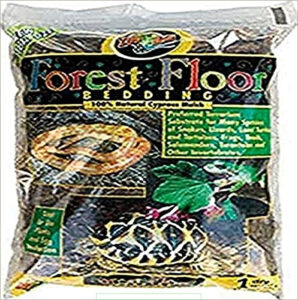
Many corn snake owners choose Zoo Med Forest Floor Bedding for its excellent humidity retention properties.
This natural cypress mulch creates an authentic forest floor look while helping snakes shed more easily.
It’s particularly effective for maintaining consistent humidity levels, outlasting aspen bedding between changes.
The 9-pound bag fills a standard terrarium with 2-3 inches of substrate depth.
While it does an excellent job retaining moisture, you’ll need to watch for waste as it can blend with the mulch color.
Not recommended for in-tank feeding due to potential ingestion risks.
It is also worth noting the importance of monitoring the substrate to prevent any issues, and the authentic forest floor look it provides can be a great addition to a terrarium.
Best For: Snake, amphibian, and tropical tortoise owners looking for a natural-looking substrate with excellent humidity retention.
- Waste can blend into the substrate, making cleaning difficult.
- Not safe for in-tank feeding due to ingestion risks.
- Occasional large or sharp pieces may require manual removal.
- Retains moisture well, making it ideal for maintaining humidity.
- Creates a natural forest floor aesthetic for terrariums.
- Affordable and lasts longer between changes compared to aspen bedding.
3. Rural365 Hemp Bedding for Chickens
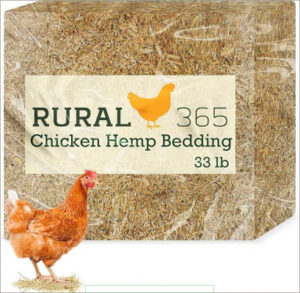
While designed primarily for poultry, Rural365 Hemp Bedding offers impressive benefits for corn snake enclosures.
This substrate absorbs up to 4 times its weight, effectively trapping odors and maintaining proper humidity levels. The chemical-free composition provides a safe environment for your snake to burrow naturally.
At 32.5 pounds per bale, it’s an economical long-term choice despite the higher initial cost. The soft, fluffy texture promotes natural behaviors while resisting mold growth.
For corn snake owners seeking sustainable options, this compostable bedding delivers excellent moisture control and easy maintenance, making it a great choice for those looking for a safe and natural environment.
Best For: Corn snake owners or small animal caretakers seeking sustainable, chemical-free, and highly absorbent bedding.
- Absorbs up to 4 times its weight, providing excellent humidity control.
- Compostable and eco-friendly material reduces environmental impact.
- Soft, fluffy texture promotes natural burrowing and comfort.
- Higher initial cost compared to other bedding options.
- Bulk size may be larger than necessary for small enclosures.
- Requires regular monitoring to prevent excessive moisture buildup.
4. Zoo Med Eco Earth Substrate
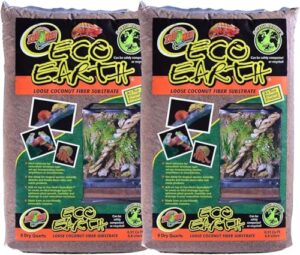
Eco Earth’s coconut-based formula creates an ideal environment for your corn snake while supporting eco-friendly practices.
This renewable substrate holds up to 8 times its weight in water, making it perfect for maintaining proper humidity levels. It comes either loose or as space-saving compressed bricks that expand when wet.
The coarse texture prevents compaction and allows your snake to burrow naturally. It’s non-toxic, chemical-free, and helps absorb odors in the enclosure.
Proper selection helps prevent respiratory irritation issues. While it requires replacement when soiled, you can repurpose used substrate for gardening, giving you extra value for your money, and supporting a more renewable and sustainable approach.
Best For: Reptile and amphibian owners looking for a natural, eco-friendly substrate that maintains humidity and supports burrowing behavior.
- Eco-friendly and compostable coconut-based formula.
- Maintains humidity by holding up to eight times its weight in water.
- Versatile and can be repurposed for gardening after use.
- Dries out quickly and may need frequent replacement.
- Bulky and heavy bags can be cumbersome to manage.
- Slightly expensive compared to some other substrates.
5. Exo Terra Forest Bark Substrate
Despite its simplicity, Exo Terra Forest Bark Substrate offers remarkable benefits for corn snakes.
Made from 100% natural Douglas fir bark, this biodegradable option excels at moisture retention while absorbing odors.
The heat-treated bark prevents bacterial contamination, and its unique particle size encourages natural digging behaviors.
You’ll appreciate how it naturally regulates humidity levels—perfect for corn snakes that thrive in 30-40% humidity environments.
For best results, spread a 1-2 inch layer and spot clean daily.
The substrate’s smooth particles also minimize respiratory risks, making it one of the safest options available.
Best For: Humidity-loving reptiles and amphibians like corn snakes, geckos, and frogs, as well as tropical plant enthusiasts.
- Excellent moisture retention and humidity regulation.
- Encourages natural digging and burrowing behaviors.
- Biodegradable, eco-friendly, and minimizes respiratory risks.
- Requires rinsing before use to remove dust.
- Needs regular spot cleaning to maintain cleanliness.
- May not be ideal for reptiles preferring drier environments.
6. Zilla Alfalfa Reptile Bedding 15lb
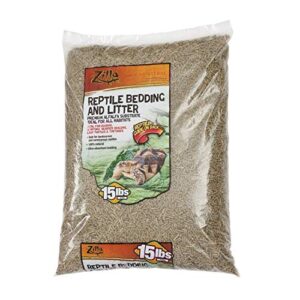
The Zilla Alfalfa Reptile Bedding offers a unique approach to corn snake habitat maintenance.
This 15-pound package contains 100% natural alfalfa-based substrate that’s ultra-absorbent and safe for both herbivorous and carnivorous reptiles.
It’s particularly valuable because it contains a reptile-safe bacteriostatic agent that minimizes germ growth, keeping your snake’s environment fresher.
Users appreciate how it masks odors and doesn’t stick to cage bottoms when wet.
Be aware that it may develop mold if left damp, especially under water dishes.
For best results, use it with sub-adult or adult corn snakes.
Best For: Sub-adult or adult corn snake owners looking for a natural, odor-masking substrate that is safe if accidentally ingested.
- Made from 100% natural alfalfa and safe for reptiles.
- Contains a bacteriostatic agent to reduce germ growth and odors.
- Easy to clean and does not stick to the bottom of the cage when wet.
- Strong alfalfa smell may be unpleasant for some users.
- Can develop mold if left wet, especially under water dishes.
- May not be suitable as the sole substrate due to maintenance challenges.
7. Zilla Green Reptile Terrarium Substrate

Frequently chosen by corn snake owners, Zilla Green Reptile Terrarium Substrate offers a practical alternative to loose beddings.
This carpet-style substrate prevents accidental ingestion risks while providing comfortable footing for your snake.
It’s treated with an odor-reducing enzyme to keep habitats fresh and can be easily cleaned by rinsing with cold water.
While it doesn’t allow for natural burrowing behavior, the non-abrasive material is gentle on your corn snake’s body.
For best results, purchase multiple pieces to rotate while cleaning, as this substrate works well for beginners prioritizing easy maintenance and snake safety.
Best For: Beginners and reptile owners prioritizing easy maintenance and safety in a low-fuss habitat.
- Easy to clean by rinsing with cold water.
- Prevents accidental ingestion, ensuring reptile safety.
- Treated with odor-reducing enzyme for a fresh habitat.
- Doesn’t allow for natural burrowing behaviors.
- Hardened waste can be difficult to remove.
- Not suitable for use with under-tank heaters without proper securing.
Substrate Safety Considerations
You’ll need to choose non-toxic substrates for your corn snake to prevent health issues like respiratory problems and impaction risks.
Proper substrate selection prevents mite infestations and bacteria growth, creating a safe environment for your scaly friend, which also helps prevent respiratory problems.
Salmonella Prevention
All reptiles, including corn snakes, can carry Salmonella bacteria in their digestive systems.
Always wash your hands before and after handling your snake or cleaning its enclosure.
Choose safe substrates that are easy to disinfect regularly, and use reptile-specific disinfectants for enclosure cleaning.
Proper hygiene practices include maintaining separate cleaning tools for your snake’s habitat to protect both human health and snake health.
Mite Infestations
Mites can silently invade your corn snake substrate and cause serious health issues.
Regularly inspect your snake bedding for tiny black parasites using a magnifying glass.
Choose mite-resistant substrates like aspen or ReptiChip and quarantine new substrate before use.
One key step involves following a snake mite infestation prevention guide to minimize risks.
If you spot mites, immediately replace with paper towels, treat your snake with appropriate solutions, and thoroughly disinfect the enclosure.
Prevention is always easier than dealing with an established infestation.
Respiratory Irritation
While dealing with mites is challenging, protecting your corn snake from respiratory irritation is equally important.
Cedar and pine substrates release aromatic oils and VOCs that can cause serious respiratory damage to your pet.
Dust inhalation from dry substrates like untreated Eco Earth can irritate sensitive lungs.
Choose low dust snake bedding like aspen or ReptiChip, and maintain proper ventilation to prevent ammonia buildup and mold exposure.
Natural-Looking Vivarium
Many corn snake owners prefer creating a natural-looking vivarium that mimics the snake’s native habitat while ensuring safety.
A naturalistic reptile habitat offers both aesthetic appeal and enrichment.
To create such an environment, consider the following elements:
- Choose substrates compatible with live plants
- Provide 3+ inches of burrowing depth
- Consider bioactive benefits for long-term maintenance
- Incorporate naturalistic design elements like branches and rocks
- Create enrichment opportunities through varied textures and hiding spots
Substrate Maintenance Tips
You’ll need to maintain your corn snake’s substrate through regular spot cleaning and complete replacement every 1-2 months for peak health.
Proper maintenance prevents harmful bacteria growth and guarantees your reptile friend has a clean, comfortable environment that supports natural behaviors like burrowing.
Regular Cleaning and Replacement
Regular cleaning and replacement of your corn snake’s substrate creates the foundation for a healthy habitat.
Spot cleaning should be done daily, removing waste and soiled bedding immediately. For full replacement, mark your calendar for every 3-4 weeks.
During this enclosure maintenance, sanitize all surfaces with reptile-safe disinfectant. Using a reptile-safe cleaner is essential for their health.
Following proper substrate replacement frequency prevents odors and reduces disease risk, ensuring your pet thrives in clean conditions.
Preventing Bacterial Growth
Preventing bacterial growth starts with waste removal and substrate sanitization.
Use a veterinary disinfectant to clean the enclosure, ensuring proper ventilation to avoid fungal growth.
Substrate choice matters—pick materials that resist mold and are easy to clean.
An antibacterial enclosure setup combined with regular replacement keeps harmful bacteria in check, creating a safe, hygienic space for your corn snake.
Corn snakes, with their lifespan of 20+ years, require a long-term commitment to maintaining a clean habitat.
Maintaining Optimal Humidity
To maintain ideal humidity, monitor humidity levels regularly and adjust substrate depth as needed.
Use materials with strong moisture retention for effective humidity regulation in snake enclosures.
Add humid hides with damp moss to prevent scale rot and aid shedding success.
Consider using a digital hygrometer for accurate readings.
A balance of humidity control and proper airflow supports comfort and guarantees reptile humidity control for your corn snake.
Ensuring Snake Health and Comfort
To guarantee your corn snake’s health, prioritize safe snake bedding and proper substrate depth (2-3 inches).
This supports burrowing behavior and prevents scale rot. Keep the environment clean to avoid shedding issues.
- Use non-toxic options like aspen or coconut fiber.
- Spot-clean daily to remove waste.
- Replace substrate regularly for ideal humidity control and safe corn snake care.
Frequently Asked Questions (FAQs)
How do substrates affect corn snake shedding?
Funny how it works—your corn snake’s shedding depends a lot on humidity.
The right substrate, like coconut fiber or cypress mulch, holds moisture, preventing dry skin and ensuring smooth, comfortable sheds for your snake.
Can mixed substrates improve burrowing and humidity balance?
Combining substrates like coconut fiber and cypress mulch can create a balance for burrowing and humidity.
The mix holds moisture well, mimics natural habitats, and allows your corn snake to dig comfortably while maintaining proper enclosure conditions.
This structure allows for proper enclosure conditions, ensuring the well-being of the corn snake.
What substrates are best for odor control?
Cypress mulch and ReptiChip are excellent for odor control. They absorb smells effectively and resist bacterial growth.
Hemp bedding works well too, offering natural odor absorption while staying eco-friendly and easy to clean.
Are bioactive setups suitable for all corn snakes?
Bioactive setups can work for most corn snakes if you meet their needs.
Focus on proper humidity, safe plants, and healthy microfauna.
Some snakes may need simpler environments if they struggle with complex bioactive setups.
How does substrate choice impact vivarium aesthetics?
Your substrate choice isn’t just about function—it’s like choosing the carpet for a room.
It impacts the vivarium’s style, highlighting natural themes, bright tones, or earthy vibes.
Plus, it enhances your snake’s habitat’s realism.
Conclusion
Finding the right bedding for your corn snake is the foundation of a healthy, comfortable habitat.
Each substrate has unique strengths, from aspen shavings to cypress mulch, and choosing the best fit depends on your snake’s needs and environment.
Prioritize absorbency, safety, and ease of maintenance while promoting natural behaviors like burrowing.
By carefully comparing corn snake substrate options, you’ll create a thriving setup that’s both practical and supportive of your snake’s well-being.
Start small, and choose wisely.

